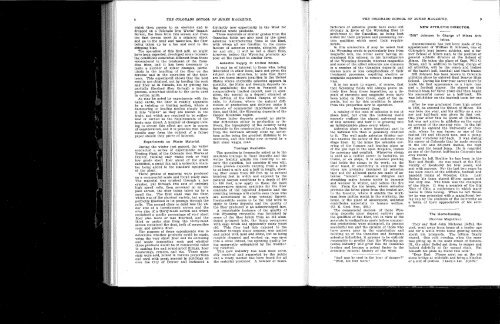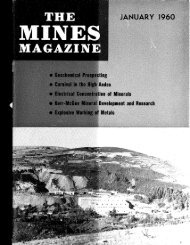COLORADO SCHOOL OF MINES MAGAZINE
COLORADO SCHOOL OF MINES MAGAZINE
COLORADO SCHOOL OF MINES MAGAZINE
- No tags were found...
You also want an ePaper? Increase the reach of your titles
YUMPU automatically turns print PDFs into web optimized ePapers that Google loves.
8 TEE OOLORADO SOHOOL OE <strong>MINES</strong> <strong>MAGAZINE</strong>.TEE OOLOBADO SGEOOL OE <strong>MINES</strong> <strong>MAGAZINE</strong>. 9which then passes to an elevator and isdropped on a Coiorado Iron Works' ImpactScreen, the fines from this screen and fromthe flrst screen meet in a common shootand go to the sand and waste-box, the fiberbeing taken up by a fan and sent to theshipping bins.The operation of this first mill, as migbthave been expected, developed some interestingconditions somewhat difEerent from thoseencountered in tbe treatment of the Canadianfiber, and it has been necessary tomake a number of minor changes, particularlyin the handling of the fiber on tbescreens and in the operation of tbe flberizers.This experiment shows that the bestresults are obtained, not by beating the rockand fiber as in Canada, but by putting thepartially fiberized fiber through a tearingprocess, somewhat similar to the cards usedin cotton mills.As may be noted by experiments with thehand cards, tbe fiber is readily separableby a twisting or tearing motion, where ahammering or beating motion simply beatsit into "sticks" as they are known in thetrade, and which are required to be reflberizedor carded as the requirements of thetrade may direct. A number of changes lookingto secure this effect are now in courseof consideration, and it is possible tbat theseresults may form tbe subject of a futurepaper should they prove of interest.Experiments on WasteIVi ater ial,During the winter just passed, the writerconducted a series of experiments at theTesting Plant of the Colorado Iron Works atDenver, running only waste rock or verylow grade short fiber about of the gradeexhibited, a small fan and a collection chamberbeing added to tbe standard equipmentof the plant.Three grades of material were producedon a commercial scale and found ready sale.The material was crushed through a jawcrusher, put through two sets of ordinaryhigb speed rolls, then screened on an impactscreen, the flber being taken up by asmall fan. Tbe first class was the fiber,which was of tbe shortest variety, but nearlyperfectly fiberized in its passage through therolls. Tbe second class or sand was the undersize of a twenty-mesh screen and theover size of a thirty-mesh screen and whichcontained a goodly percentage of very shortfiber also more or less fiberized, and thethird or under size from the thirty-meshscreen contained the dust, both of serpentinerock and minute fiber.The purpose of tbese experiments was todetermine whether products could be made,using the very short fiber and its enclosingand waste serpentine rock and whetherthese products would be of commercial valuein making fire and sound-proof fillings, floordeadenings, cement, and etc. These materialswere sold, mixed in various porportionsand used witb great success in buildings aliover the City of Denver and instanced adistinctly new opportunity in the West forasbestos waste products.These materials or similar gi-ades from theCanadian flelds are also used by the greatasbestos manufacturing firms in tbe East,witb whom all are familiar, in tbe manufactureof asbestos cements, shingles, plasterand etc.; it will be but a short time,however, before the Wyoming products appearon the market in similar form.Asbestos Supply in United States.It may be of interest to those wbo, beinginterested in other lines, have not given thesubject much attention, to note that tbereare but three known localities in tbe UnitedStates where chrysotile asbestos appears inquantity, the Idaho and Georgia deposits beingamphibole; tbe first in Vermont in acomparatively limited deposit, now in operation,the second in a deposit situated attbe bottom of the Grand Canyon of Colorado,in Arizona, where the natural difficultiesof production and delivery make itscarcely of commercial importance at thistime, and third, the Wyoming deposits of theCasper Mountain region.These latter deposits present no particulardifficulties either in production or delivery,tbe topography of the country beingfavorable to the construction of branch linesfrom the railroads already close by, seventeenmiles being the greatest distance to beovercome, and this being now covered by afirst class wagon road.TonnageAvailable.The question is frequently asked as to theavailable tonnage in these deposits and tbewriter frankly admits his inability to answerthe question, but consider if you will,three proven deposits varying from a mileto at least a mile and a half in length, showingfiber zones from 100 feet iip to severalhundred feet in width and exposed by thenatural canyon conditions to a depth of 400to 800 feet, now apply to these the mostconservative figures available for the fibercontents ot the exploited deposits and tberesulting tonnage will startle even those whoare accustomed to large tonnage figures.Inexhaustible seems to be tbe real word toapply to these deposits and the quality ofthe fiber produced is an acknowledged fact.A remarkable instance of the quality oftbis Wyoming chrysotile was furnished bysome of tbe fiber talten from an old abandonedpi-ospect hole, the dump overgrownwith sage brush and apparently many yearsold. Tbis flber bad lain exposed to theweather through many seasons, was mattedand calted with mud and slime, but on beingroughly cleansed and worked up, was spuninto a stout thread, the spinning quality beingapparently unimpaired by the weatheringreceived.This new industry has been most cordiallyreceived and supported by the publicand a ready market has been found for allthe material produced. A number of manu-facturers of asbestos goods have come outstrongly in favor of tbe Wyoming flber inpreference to tbe Canadian, as being bestsuited for their purposes and possessing certainqiialities which meet their requirements.In this connection it may be noted thatthe Wyoming crude is particularly free frommagnetic iron, tbe writer never having encounteredthis mineral in his investigationOf the Wyoming deposits, whereas magnetiteand some of the allied minerals are commonin a number of the Canadian deposits andcauses more or less complications of theirtreatment processes, requiring electric ormagnetic separators to remove these impurities.It is too much to expect, of course, thatthat Wyoming flelds will always prove entirelyfree from tbese impurities, as a depositof chromite and magnetic irons havebeen noted on Deer Creek, east of the deposits,but so far tbis condition is absentfrom tbe properties now in operation.Increased Uses.A catalog of the uses of asbestos is out ofplace here, but even tbe technical worldscarcely realizes the almost universal useof this mineral and bow it is growing intoan indispensable place every where.Asbestos plays a more important part inthe national life than is generally creditedto it. The well made asbestos theater curtainassures the safety of the audience fromstage fires. In the home the asbestos coveringof the furnace and heating pipes orof tbe gas logs in the open fireplace, makesfor economy and comfort. Wherever steamis nsed as a motive power in factories, ontrains, or on ships, it is asbestos pacldngthat holds the steam to its work; on theother band, it electricity is employed thewires are probably insulated by asbestostape and the adjacent parts are made of asbestos"lumber." Asbestos shingles andsheathing make houses cooler in summerand warmer in winter, and reduce the flrerisk. Prom the ice bouse, where asbestosprotects the brine pipes from the heated air,to the foundry, where it shields tbe workmanfrom molten metal, in the workship, tbehome, or tbe place of amusement, asbestoscontributes materially to human welfare.(U. S. GeoL Sur., 456.)The commercial success of these Wyomingdeposits must depend entirely uponthe qualities of the fiber, but in view of theaccurate investigations made before commercialproductions were attempted, its presentsuccessful use and the opinion of those whobave grown gray in the exploitation andbuilding up of the Canadian and Europeanasbestos industries, it appears to be entirelyreasonable to predict tbat the Wyoming asbestosindustry wlli grow like its Canadianbrother and become a potent factor in theeconomic mineral history of the West."And was he cool in the hour of danger?""Well, his feet were."NEW ATHLETIC DIRECTOR."Bill" Johnson in Charge of IVIines Athletics.Announcement has just been made of theappointment of William E. .Tohnson, one ofColorado's best known athletes, and a formerSchool of Mines man, to the position ofgeneral athletic director at the School ofMines. He takes the place of Capt. Will C.Bryan, and in addition to having charge ofall athletics, will be the coach and trainerof the basket ball, baseball and track teams.Bill Johnson has been known in Coloradoathletics since he entered Bast Denver HighSchool. During his four-year career there bemade his first appearance as a track manand a football player. He played on thefootball team for three years and then beganhis successful career as a half-back. Hewas left-fielder on the baseball team for oneyear.After he was graduated from high schoolin 1901, he entered the School of Mines. Hewas here one year, and his ability as a runnerand half-hack was given its first test.One year after this he spent at California,but was not active in athletics on the coaston account of the one-year rule. In the fallof 1903 he entered the University of Colorado,where be was known as one of thefastest 100 and 220-yard men, and a plungingand vivacious half-back. It was duringhis career at Colorado that he made recordsin tbe 100 and 220-yard dashes, the higbjump and tbe broad jump. He is regardedas one of the fastest half-hacks Colorado hasever known.Since he left Boulder he has been in theEast and South, He was coach at the Universityof Kentucky for four years, andmet with success. For the last two years behas been coach of the athletics, football andbaseball teams of Wooster, Ohio. LastSpring his team played fifteen games andlost only one. The team was the championof tbe State. It was a member of tbe BigNine of Ohio, a conference to which manyteams in Ohio belong. When he left Woosterhe was presented with a magnificent lovingcup by the students of the university asa token of their appreciation of his services.TheHome-Coming.{Success Magazine.)They say tbat John Nicholas Beffel, thepoet, went away from home at a tender ageand for a while wrote home glowing lettersabout his prospects. The letters flnallyceased. One cold evening, when the snowwas piling up in the main street of Seneca,111., tbe elder Beffel sat down to supper andlooked dolefully at the vacant chair. Butbeneath his plate he found this note:"Dear Dad: Please meet me at the oldstone bridge at midnight and bring a blanketor a suit of clothes. I have a hat. JOHN."
















